Articles
- Page Path
- HOME > Korean J Community Nutr > Volume 18(5); 2013 > Article
-
Original Article
- A Study on Dietary Habits, Body Satisfaction and Nutritional Knowledge by Body Image of Middle School Girl Students in Chungbuk Area
- Jee-Young Yeon, Ki-Yong Shin, Soon-Kyu Lee, Hye-Young Lee, Baeg-Won Kang, Hye-Kyung Park
-
Korean Journal of Community Nutrition 2013;18(5):442-456.
DOI: https://doi.org/10.5720/kjcn.2013.18.5.442
Published online: October 31, 2013
Nutrition Safety Policy Division, Food Nutrition and Dietary Safety Bureau, Ministry of Food and Drug Safety, Cheongwon-gun, Korea.
1Food Nutrition and Dietary Safety Bureau, Ministry of Food and Drug Safety, Cheongwon-gun, Korea.
- Corresponding author: Hye-Kyung Park, Food Nutrition and Dietary Safety Bureau, Ministry of Food and Drug Safety, Cheongwon-gun 363-700, Korea. Tel: (043) 719-2251, Fax: (043) 719-2250, phkfda@korea.kr
Copyright © 2013 The Korean Society of Community Nutrition
This is an Open-Access article distributed under the terms of the Creative Commons Attribution Non-Commercial License (http://creativecommons.org/licenses/by-nc/3.0/) which permits unrestricted non-commercial use, distribution, and reproduction in any medium, provided the original work is properly cited.
- 132 Views
- 1 Download
- 8 Crossref
Abstract
- This study was performed to investigate the dietary habits, body satisfaction and nutritional knowledge according to body image of middle school girl students (n = 284). The subjects were classified as lean, normal and fat groups according to body image. The weight, body mass index (BMI) and the score of body image were significantly higher in the students who recognized their body image as 'fat'. The satisfaction of present body image was significantly lower in students who recognized their body image as 'lean'. The interest in weight control and experience of weight control were significantly higher in students who recognized their body image as 'fat'. The necessity of nutrition education was higher in all groups (lean 67.2%, normal 59.0% and fat 52.8%). The products used to feel sweetened were sweetened ice (68.7%), processed milk (68.3%), confectionery (62.3%), carbonated beverage (55.3%), fermented milk (38.0%) and none (6.0%). The frequency of consumption of fruit juices and fried food was significantly higher in 'normal' compared to 'fat'. There was no significant difference in the frequency of consumption of snack and nutritional knowledge among the three groups. In the multiple regression analysis, the score of body image was negatively associated with the frequency of snack consumption in the 'lean'. The score of body image was positively associated with identification of nutrition labels and an interest in weight control but was negatively associated with satisfaction of present body image in the 'fat'. Based on these results, we conclude that, the middle school girl students need correct recognition of body image and continuous and practical nutrition education in order to maintain healthy dietary habits.
- 1. Bae YJ, Yeon JY. Dietary behaviors, processed food preferences and awareness levels of nutrition labels among female university students living in middle region by breakfast eating. J Korean Diet Assoc 2011; 17(4): 387-402.
- 2. Brener ND, McManus T, Galuska DA, Lowry R, Wechsler H. Reliability and validity of self-reported height and weight among high school students. J Adolesc Health 2003; 32(4): 281-287.ArticlePubMed
- 3. Chung JY, Kim MJ. Using and understanding of nutrition labels and related factors among female adults in the Seoul area. Korean J Community Nutr 2007; 12(4): 417-425.
- 4. Cowart BJ. Relationships between taste and smell across the adult life span. Ann N Y Acad Sci 1989; 561: 39-55.PubMed
- 5. Doo MA, Seo JY, Kim YH. Factors to influence consumption pattern of snacks of middle school students in Ilsan area. J Korean Soc Food Sci Nutr 2009; 38(12): 1732-1739.
- 6. Eom HS, Jung MJ, Kim SB. A study on nutrition knowledge, dietary aittitide, food habit of middle school students in Chonbuk area. Korean J Community Nutr 2005; 10(5): 574-581.
- 7. Goh EY, Park ES. Intake of processed food and perceptions of food labeling in middle school students. Korean J Human Ecology 2010; 19(1): 179-189.
- 8. Han YS, Joo NM. An analysis on the factors of adolescent Obesity. Korean J food Cult 2005; 20(2): 172-185.
- 9. Hong KH. The influence of male college students' extent of mass media exposure on sociocultural attitude toward appearance and appearance orientation. J Korean Soc Clothing Text 2008; 32(7): 1149-1159.
- 10. Jang HS. Body image recognition, nutrition knowledge and nutrient intakes of middle school students according to the obesity index. J Korean Home Econ Educ Assoc 2006; 18(2): 97-110.
- 11. Jin YH. A comparative study on dietary habits and dietary attitudes among middle school students with different obesity indexes. Korean J Community Nutr 2002; 7(2): 156-166.
- 12. Korea Health Statistics [KHS]. Korea National Health and Nutrition Examination Survey (KNHANES V-2) 2011. 2012. p. 388-413.
- 13. Korean Pediatric Society. The standard of body growth for Korean children and adolescent at 2007. Korean Center for Disease Control and Prevention; 2007.
- 14. Kim BR, Kim YS. Dietary behaviors, body satisfaction and factors affecting the weight control interest according to gender of middle school students in Wonju area. J Korean Soc Food Sci Nutr 2010; 39(9): 1295-1304.
- 15. Kim JE, Min HS. Weight-related perceptions, practices and eating behaviors of middle school students: associations with BMI. Korean J Community Nutr 2008; 13(1): 13-23.
- 16. Kim JH. Perception and utilization of food labels depending on educational experience with the food labeling syatem in middle school students. Korean J Community Living Sci 2009; 20(1): 51-59.
- 17. Kim JY, Son SJ, Lee JE, Kim JH, Jung IK. The effects of body image satisfaction on obesity stress, weight control attitudes, and eating disorders among female junior high school students. J Korean Home Econ Assoc 2009; 47(4): 49-59.
- 18. Kim KW, Shin EM. A study on nutrition knowledge, nutritional attitudes, dietary behavior and dietary intake by weight control attempt among middle school female students. Korean J Community Nutr 2002; 7(1): 23-31.
- 19. Kim MH, Yun YH, Choi MK, Kim EY. A study on body image recognition and dietary habits of middle school students in the Chungnam area. Korean J Food Nutr 2012a; 25(2): 338-347.
- 20. Kim S, Joung K, Chae B. Dietary life and eating-out style related to breakfast frequency of male students in culinary college. Korean J Community Nutr 2007; 12(1): 13-24.
- 21. Kim YJ, Jeon ER, Yoo MJ, Jung LH. Perception and utilization of food labeling system of middle school students in Gwangju. J Korean Soc Food Sci Nutr 2012b; 41(6): 796-806.
- 22. Kim HC, Kim MR. Self-perception of body image and dieting behaviors by gender amomg high school students in Gyeongbuk province. J East Asian Soc Diet Life 2011; 21(4): 587-599.
- 23. Kim YS, Kim BR. Intake of snacks, and perceptions and use of food and nutrition labels by middle school students in Chuncheon area. J Korean Soc Food Sci Nutr 2012; 41(9): 1265-1273.
- 24. Ko SY, Kim KW. Nutrition label use, self-efficacy, snacking and eating behavior or middle school students in Kyunggi area. Korean J Community Nutr 2010; 15(4): 513-524.
- 25. Lee JH, Woo JH, Chae HJ, Lee EH, Chyun JH. Study of dietary behaviors and snack intake patterns by weight of middle school students in Incheon. Korean J Food Cult 2010; 25(4): 366-377.
- 26. Lee JS, Ha BJ. A study of the dietary attitude, dietary self-efficacy and nutrient intake among middle school students with different obesity indices in Gyeong-Nam. Korean J Community Nutr 2003; 8(2): 171-180.
- 27. Lee JS, Yun JW. A study on perception about body image, dietary attitude, dietary self-efficacy and nutrient intake of high school in Busan. J Korean Soc Food Sci Nutr 2003; 32(2): 295-301.
- 28. Story M, Neumark-Sztainer D, French S. Individual and environmental influence on adolescent eating behaviors. J Am Diet Assoc 2002; 102(S3): S40-S51.
- 29. Ministry of Food and Drug Safety [MFDS]. The report of sugar intake: 2008~2011. Cheongwon-gun: 2013.
- 30. Park JY, Ryu K, Jang HL, Yoon KY. Carbonated beverage consumption among middle school students in Daegu area. J East Asian Soc Diet Life 2010; 20(2): 201-208.
- 31. Park SS, Kim NY, Han MJ. Processed food preferences and food and nutrition labeling perceptions of middle school students. Korean J Food Cookery Sci 2008; 24(2): 164-173.
- 32. Ryu HK. A survey of adolescents' concern and perception about body image (at Miryang city). Korean J Community Nutr 1997; 2(2): 197-205.
- 33. Ryu HK, Park JA. Perception of body image, eating disorder, eating behaviors and subjective health status of female high school and college students in Daegu area. Korean J Community Living Sci 2002; 13(3): 69-80.
- 34. Sorensen TI, Stunkard AJ, Teasdale TW, Higgins MW. The accuracy of reports of weight : children's recall of their parents weights 15 years earlier. Int J Obes 1983; 7(2): 115-122.PubMed
- 35. Sung SH, Yu OK, Sohn HS, Cha YS. A comparison of dietary behaviors according to gender and obesity status of middle school students in Jeonju. J Korean Soc Food Sci Nutr 2007; 36(8): 995-1009.
- 36. Yeon JY, Hong SH, Bae YJ. A study on nutritional status and dietary quality of university students by body image. Korean J Community Nutr 2012; 17(5): 543-554.
- 37. World Health Organization [WHO]. World Health Organization (2000): The Asia-Pacific perspective: redefining obesity and its treatment. World Health Organization Western Pacific Region. International Association for the Study of Obesity; 2000.
REFERENCES

1) Determined by independent sample f test of equality of the means or chi-square tests of differences in proportions
2) Mean ± SD
3) Not Significant
4) Means with different superscripts (a~c) within a row are significantly different from each at α = 0.05 by Duncan's multiple range test
5) N (%)
6) 1 = very lean body, 9 = very fat body
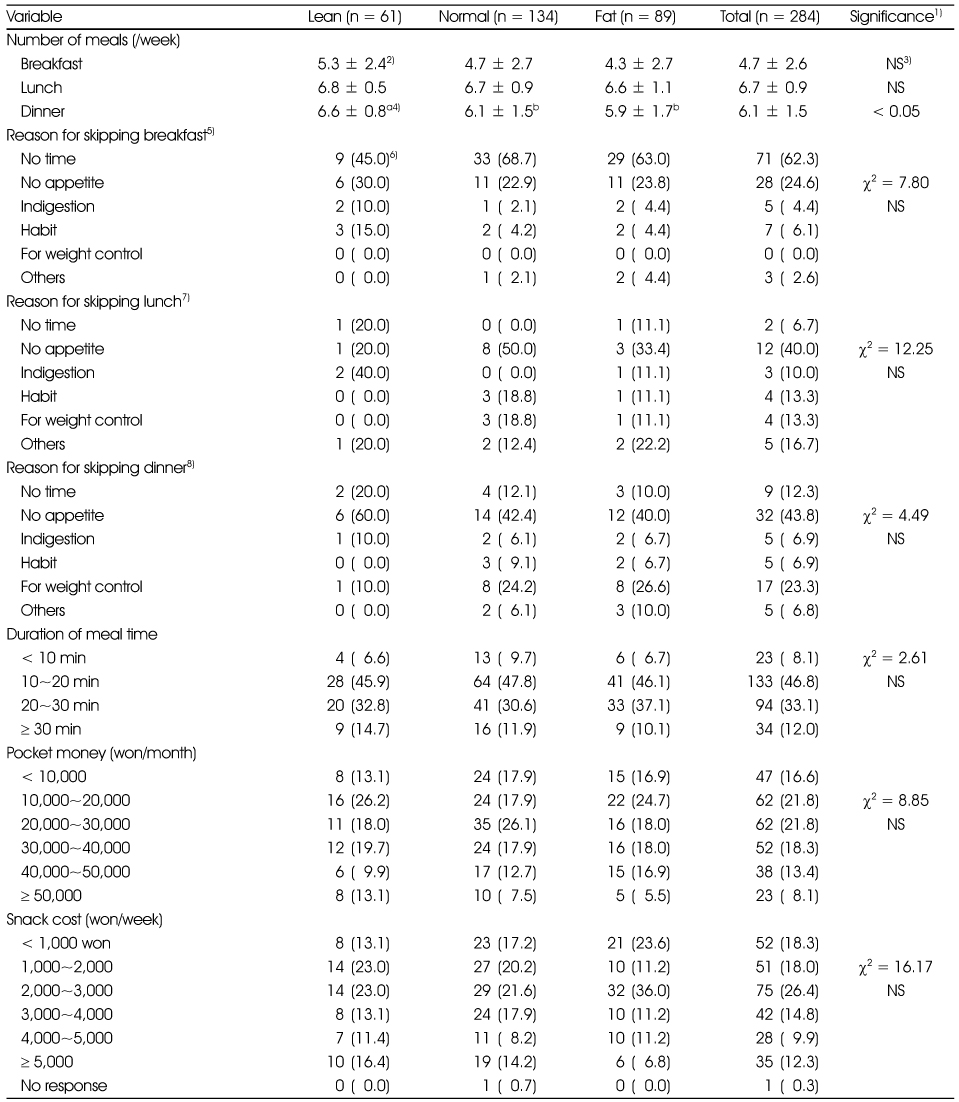
1) Determined by independent sample f test of equality of the means or chi-square tests of differences in proportions
2) Mean ± SD
3) Not Significant
4) Means with different superscripts (a~c) within a row are significantly different from each at α = 0.05 by Duncan's multiple range test
5) Except for the subject that breakfast eat everyday
6) N (%)
7) Except for the subject that eat lunch everyday
8) Except for the subject that eat dinner everyday
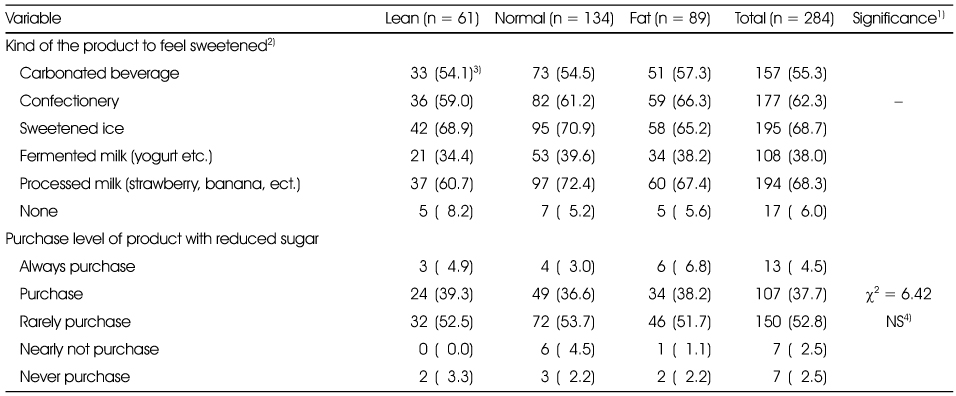
Figure & Data
REFERENCES
Citations

- Assessment of Sugar and Sodium Contents and Their Intakes in Snack Food Groups : A Focus on Cookies, Nuts, Fruits, Dairy Products, and Beverages
Yun-Jung Bae, Kyoung-A Choi, Yu-Mi Kim, Mi-Kyeong Choi
Journal of the East Asian Society of Dietary Life.2022; 32(4): 263. CrossRef - Body Weight Perception, Mental Health, and Weight Control Behavior in Normal Weight Adolescents: Based on the Korea National Health and Nutrition Examination Survey 2013-2015
Eun Jee Lee
Child Health Nursing Research.2017; 23(2): 249. CrossRef - Perception of sugar reduction, nutrition education, and frequency of snacking in children by the self-perceived sweet dietary habits of mothers in Busan
Jee-Young Yeon, Soon-Kyu Lee
Nutrition Research and Practice.2016; 10(5): 546. CrossRef - Dietary Behaviors and Total Sugar Intake from Snacks of Female College Students according to Sweet Taste Perception
Mi-Hyun Kim, Yun-Jung Bae, Jee-Young Yeon
The Korean Journal of Food And Nutrition.2016; 29(2): 267. CrossRef - Comparative Study on Dietary Habits, Unbalanced Diet and Intake of Food Groups in Middle School Students - by Gender and Region -
Myung-Hee Kim
Journal of the East Asian Society of Dietary Life.2015; 25(1): 1. CrossRef - A Comparison of Body Image and Dietary Behavior in Middle and High School girls in Gyeongbuk Area
Hye-Jin Kim, Kyung-A Lee
Korean journal of food and cookery science.2015; 31(4): 497. CrossRef - Recognition and Usage of Nutrition Labeling for Processed Foods and Restaurant Meals according to the Effort Level of Healthy Dietary Behavior in 5th Grade Elementary School Girls
Jin-Ah Moon, Jung-Eun Kong, Gui-Im Moon, Baeg-Won Kang, Jee-Young Yeon
The Korean Journal of Food And Nutrition.2015; 28(5): 849. CrossRef - Associations of Eating Habits with Obesity and Nutrition Knowledge for Middle and High School Adolescents in Shanghai and Heze China
Yang Song, Hyo-Jin Ahn, Ji-Hye Choi, Se-Young Oh
Journal of The Korean Society of Food Culture.2014; 29(6): 648. CrossRef
Age and anthropometric measurements of the subjects by body image
1) Determined by independent sample f test of equality of the means or chi-square tests of differences in proportions
2) Mean ± SD
3) Not Significant
4) Means with different superscripts (a~c) within a row are significantly different from each at α = 0.05 by Duncan's multiple range test
5) N (%)
6) 1 = very lean body, 9 = very fat body
Dietary habits, pocket money and snack cost of the subjects by body image
1) Determined by independent sample f test of equality of the means or chi-square tests of differences in proportions
2) Mean ± SD
3) Not Significant
4) Means with different superscripts (a~c) within a row are significantly different from each at α = 0.05 by Duncan's multiple range test
5) Except for the subject that breakfast eat everyday
6) N (%)
7) Except for the subject that eat lunch everyday
8) Except for the subject that eat dinner everyday
Satisfaction with body image and interest inweight control of the subjects by body image
1) Determined by chi-square tests of differences in proportions
2) N (%)
3) The respondents with experience of weight control
Identification of nutrition labels on food of the subjects by body image
1) Determined by chi-square tests of differences in proportions
2) N (%)
3) Not Significant
Type of the product to feel sweetened and level of purchase level of product with reduced sugar of the subjects by body image
1) Determined by chi-square tests of differences in proportions
2) Respondents were allowed to select multiple choices
3) N (%)
4) Not Significant
Frequency of snack intake and consideration of snack selection of the subjects by body image
1) Determined by chi-square tests of differences in proportions
2) N (%)
3) Not Significant
Intake frequency of type of snack items of the subjects by body image
1) Determined by independent sample f test of equality of the means
2) Mean ± SD
3) Not Significant
4) Means with different superscripts (a~c) within a row are significantly different from each at α = 0.05 by Duncan's multiple range test.
Nutritional knowledge of the subjects by body image
1) Determined by independent sample f test of equality of the means or chi-square tests of differences in proportions
2) N (%)
3) Not Significant
Correlations between variables and score of present body image
1) 1 = very lean body, 9 = very fat body
2) 1 = never identify, 5 = certainly identify
3) 1 = very unconcerned, 5 = very concerned
4) 1 = very dissatisfied, 5 = very satisfied
5) 1 = low score, 12 = high score
*: p < 0.05, **: p < 0.01, ***: p < 0.001
1) Determined by independent sample f test of equality of the means or chi-square tests of differences in proportions 2) Mean ± SD 3) Not Significant 4) Means with different superscripts (a~c) within a row are significantly different from each at α = 0.05 by Duncan's multiple range test 5) N (%) 6) 1 = very lean body, 9 = very fat body
1) Determined by independent sample f test of equality of the means or chi-square tests of differences in proportions 2) Mean ± SD 3) Not Significant 4) Means with different superscripts (a~c) within a row are significantly different from each at α = 0.05 by Duncan's multiple range test 5) Except for the subject that breakfast eat everyday 6) N (%) 7) Except for the subject that eat lunch everyday 8) Except for the subject that eat dinner everyday
1) Determined by chi-square tests of differences in proportions 2) N (%) 3) The respondents with experience of weight control
1) Determined by chi-square tests of differences in proportions 2) N (%) 3) Not Significant
1) Determined by chi-square tests of differences in proportions 2) Respondents were allowed to select multiple choices 3) N (%) 4) Not Significant
1) Determined by chi-square tests of differences in proportions 2) N (%) 3) Not Significant
1) Determined by independent sample f test of equality of the means 2) Mean ± SD 3) Not Significant 4) Means with different superscripts (a~c) within a row are significantly different from each at α = 0.05 by Duncan's multiple range test.
1) Determined by independent sample f test of equality of the means or chi-square tests of differences in proportions 2) N (%) 3) Not Significant
1) 1 = very lean body, 9 = very fat body 2) 1 = never identify, 5 = certainly identify 3) 1 = very unconcerned, 5 = very concerned 4) 1 = very dissatisfied, 5 = very satisfied 5) 1 = low score, 12 = high score *: p < 0.05, **: p < 0.01, ***: p < 0.001

 KSCN
KSCN
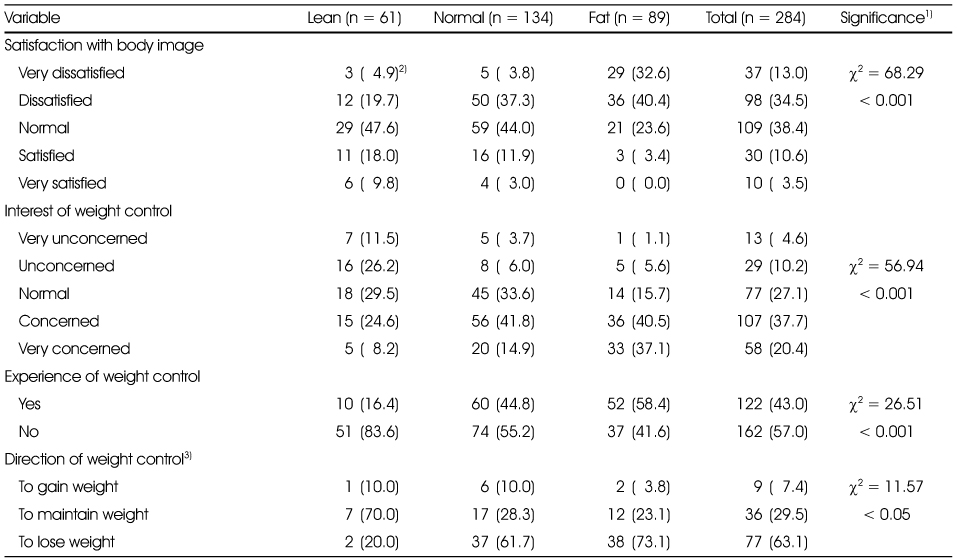
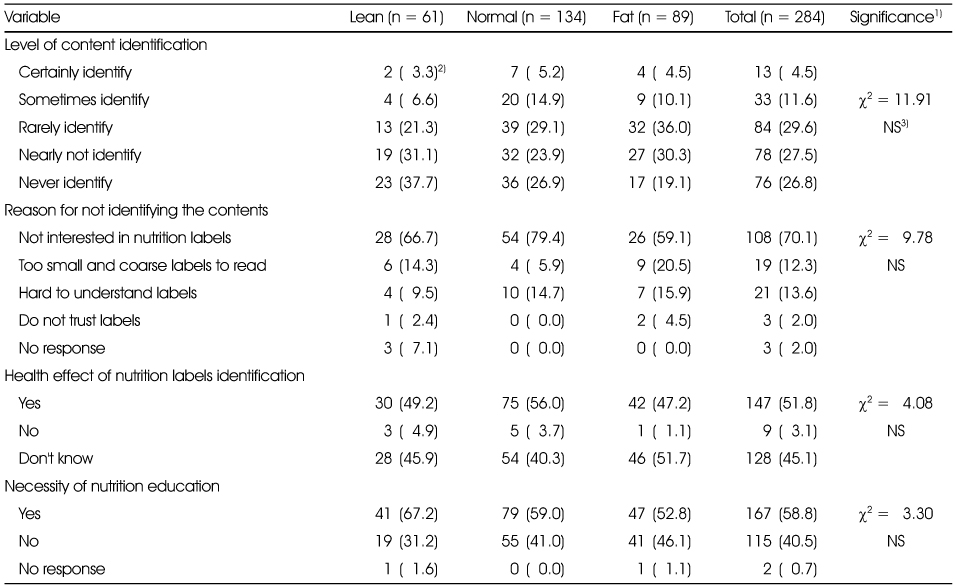
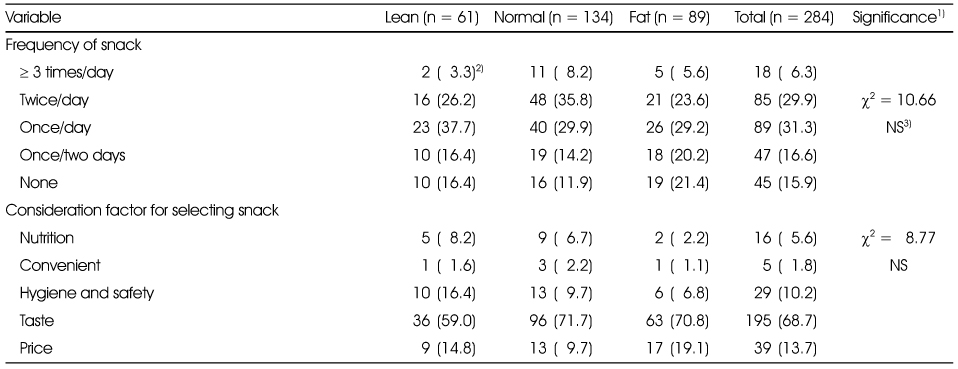
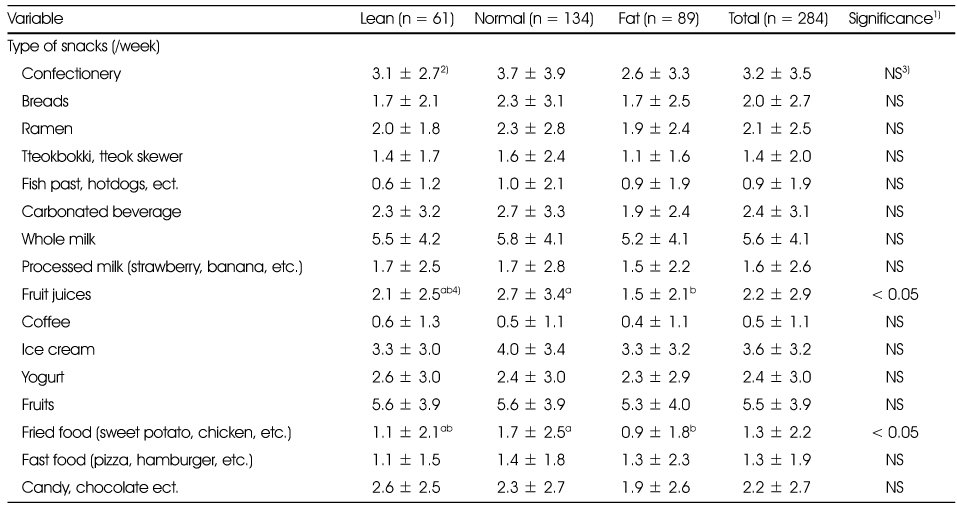
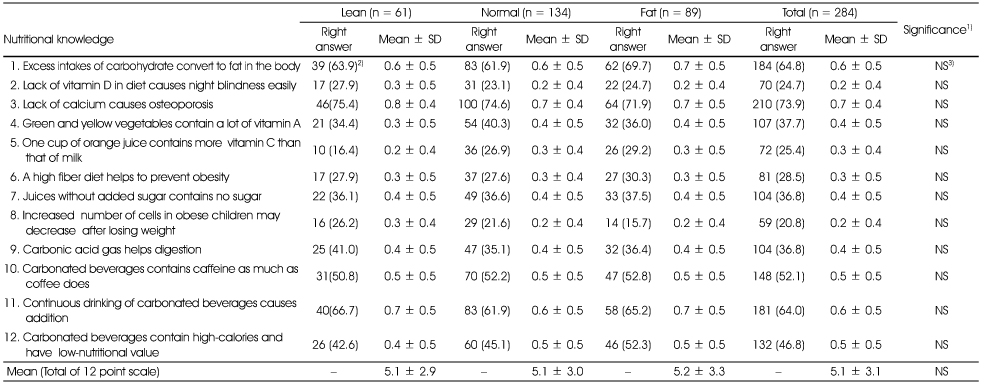

 PubReader
PubReader Cite
Cite


